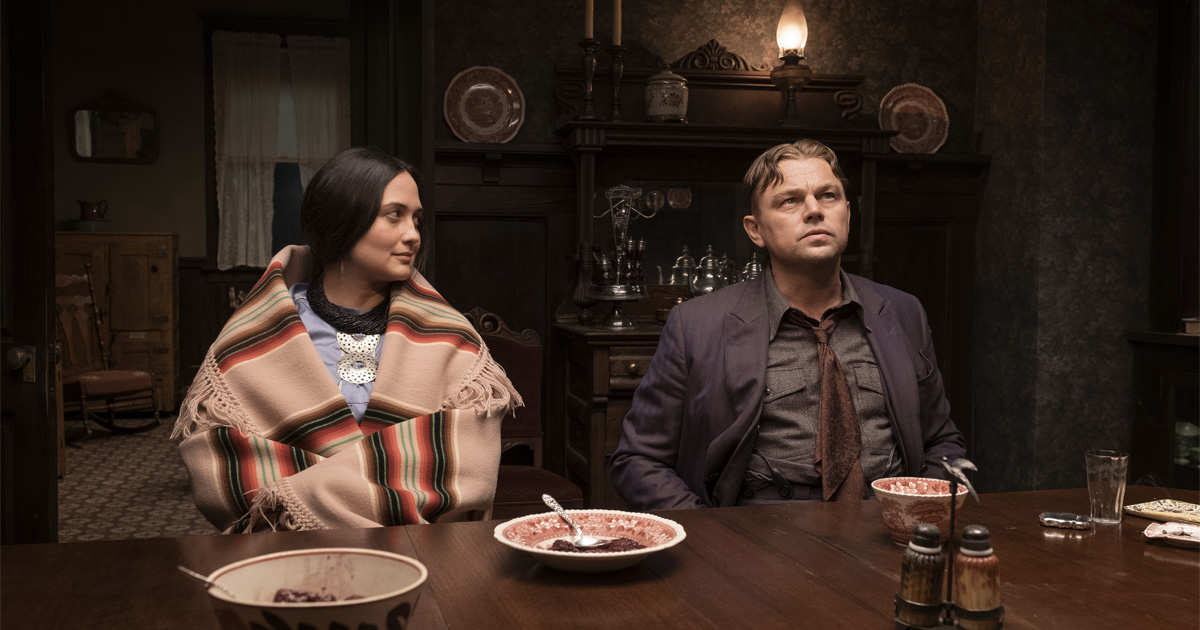
Martin Scorsese is a director whose grasp on the nature of crime is so firm he could wield it with any genre, be it a gangster story within cities (Goodfellas) or a religious tale amid villages (Silence). For Killers of the Flower Moon, he weaves that same thoughtful filmmaking over a historical Western of a small town, centering around the 1920s murders against the Osage tribe. As expected, it comes bundled with fantastic performances, stunning cinematography, and a sense of dread that builds up to a suitably cathartic finale.
The Osage Nation is established in this film as profitable and regretfully turns its back on most traditions in favor of profit. The rich tribe soon attracts white vultures seeking to marry, extort, and kill their way into those profits. The hungriest is William King Hale (Robert De Niro), a cattle rancher and trader with a heavy hand in politics. With his nephew Ernest (Leonardo DiCaprio) home from the war, William convinces his troublesome kin to pursue a life of manipulation. By day, Ernest grows fond of the lovely Mollie Burkhart (Lily Gladstone), a Native American he seeks to wed under his uncle’s financial encouragement. By night (and sometimes by day), he conspires to steal and kill to make it rich. Before betting stolen jewelry on a card game, he blatantly states that he loves money, in case it wasn’t clear.
The story is initially framed in a way that seems like Ernest goes native in his initial plan to con the tribe out of their wealth but it never gives Ernest a chance at redemption, considering his crimes. He tries to balance married life and a life of crime, but it won’t last forever. William continues to orchestrate deaths that lead his family closer and closer to gobbling up all that was Mollie’s. Her trust dwindles as lives are lost, and Osage County turns into a bloodbath, where anybody who gets close is killed with little to no investigation made. Only when the newly formed FBI steps in do the conspiring white folks start to sweat and make Ernest better contemplate the hell he has placed himself within.
There’s a host of notable performances here, but the stand-out is clearly Gladstone, perfectly playing a woman who transforms from the sly-witted woman who knows what she wants to a desperate and sick mess who doesn’t know who she can trust. DiCaprio does alright, but he’s been down this familiar arc with Scorsese’s Wolf of Wall Street, although he’s really trying with that Southern accent here. De Niro brings his A-game for being the prominent antagonist who effortlessly weasels his way into the Osage and quietly pushes his dark methods, going so far as to calm Ernest when things get too hairy with a staged suicide that looks more like murder.
The massive roster is only given a few scenes to shine truly. Jesse Plemons doesn’t show up until the third act as an FBI agent who saunters around in his investigation, keeping it cordial while finding justice. John Lithgow brings his collected dignity to the prosecutor’s role, asking the tough questions. Brendan Fraser embodies the blustering lawyer of William well in the two scenes where he gets to raise his voice. Surprisingly, Scorsese seems to save his on-screen appearance for one of the film’s most poignant moments to clarify what this story is all about.
The pacing is slick and brutal, as the film briskly sets the tone of the many murders and dark deals behind closed doors. The violence is cold and cruel, where the first few murders are kept off-screen until that sequence ends with a mother being shot right beside her baby. The brutality hits hard, even when you know someone is taking a bullet in the following scenes. The aftermath of the bodies being handled and essentially dismantled is gutwrenching. On the other side of the spectrum are some gorgeous shots of the countryside and the small town, highlighting everything from motorcar races through the streets to the shady moonshine operation in the woods. It’s a fully realized world that is visually astounding, especially for the scene of Will burning his land for insurance while Ernest stews in self-hatred over what he’s done to his ailing wife.
Killers of the Flower Moon explores so many angles and characters of the Osage County murders and yet never becomes lost with its firm focus on the unfolding crime. Martin Scorsese treats this material with great maturity and insight that calling this film a crime picture feels too simplistic. It treats the corruption of culture amid capitalism with vicious anger and sadness. It treats death with a sense of dread, where Mollie finds herself fully prepared to meet this fate with her spirituality having given her previews of the other side. It showcases the land’s beauty and the horrors of exploiting it for personal gain. It’s a film that’s more than just reviewing the evidence; it’s a challenge to recognize these horrors and ask if we can see them again when they seem so blatant in hindsight.

 “My Spy: The Eternal City” Review
“My Spy: The Eternal City” Review  “Deadpool & Wolverine” Review
“Deadpool & Wolverine” Review  “The Boys: Season Four” Review
“The Boys: Season Four” Review  “The American Society of Magical Negroes” Review
“The American Society of Magical Negroes” Review  “Twisters” Review
“Twisters” Review  “Sausage Party: Foodtopia” Review
“Sausage Party: Foodtopia” Review  “Robot Dreams” Review
“Robot Dreams” Review  “Godzilla x Kong: The New Empire” Review
“Godzilla x Kong: The New Empire” Review 


